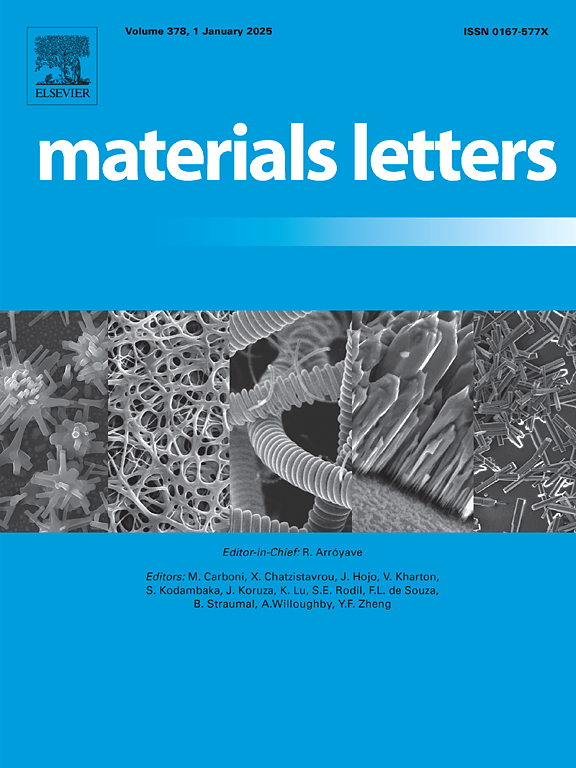Unveiling the hot cracking mechanism in Ti2AlNb-based alloys during fusion welding
IF 2.7
4区 材料科学
Q3 MATERIALS SCIENCE, MULTIDISCIPLINARY
引用次数: 0
Abstract
Solidification cracks in fusion welds of Ti2AlNb-based alloys severely deteriorate joint mechanical properties. This study reveals through systematic experiments that the cracking mechanism stems from the coupling of metallurgical and mechanical factors. Results show that low-melting-point liquid films and thermal stress are the main causes of solidification cracking. During non-equilibrium solidification, Al solute segregation forms low-melting-point liquid films, weakening grain boundaries. Specifically, high-angle grain boundaries (HAGBs) with high grain boundary energy increase the critical coalescence undercooling, keeping liquid films stable at lower temperatures. Intense thermal stress from rapid heating/cooling and structural stress from coarse columnar grains during welding easily induce liquid film rupture. Thermodynamic simulations confirm that steep temperature gradients during solidification drive the formation of columnar grains with high aspect ratios in welds, which hinder residual liquid from backfilling ruptured liquid films, increasing hot cracking susceptibility. This study provides fundamental insights into microstructural determinants of weld cracking and lays a theoretical foundation for optimizing welding parameters to enhance joint integrity of Ti2AlNb-based components.
揭示ti2alnb基合金熔焊热裂机理
ti2alnb基合金熔焊焊缝中的凝固裂纹严重影响了接头的力学性能。本研究通过系统的实验揭示了其开裂机理是冶金和力学因素耦合作用的结果。结果表明,低熔点液膜和热应力是导致凝固开裂的主要原因。在非平衡凝固过程中,Al溶质偏析形成低熔点液膜,削弱晶界。具体而言,具有高晶界能的高角度晶界(HAGBs)提高了临界聚结过冷度,使液膜在较低温度下保持稳定。焊接过程中快速加热/冷却产生的强热应力和粗柱状晶粒产生的组织应力容易导致液膜破裂。热力学模拟证实,凝固过程中陡峭的温度梯度驱动焊缝中形成高长径比的柱状晶粒,这阻碍了残余液体回填破裂的液膜,增加了热裂敏感性。本研究对焊缝开裂的微观组织决定因素提供了基础性的认识,并为优化焊接参数以提高ti2alnb基构件的接头完整性奠定了理论基础。
本文章由计算机程序翻译,如有差异,请以英文原文为准。
求助全文
约1分钟内获得全文
求助全文
来源期刊

Materials Letters
工程技术-材料科学:综合
CiteScore
5.60
自引率
3.30%
发文量
1948
审稿时长
50 days
期刊介绍:
Materials Letters has an open access mirror journal Materials Letters: X, sharing the same aims and scope, editorial team, submission system and rigorous peer review.
Materials Letters is dedicated to publishing novel, cutting edge reports of broad interest to the materials community. The journal provides a forum for materials scientists and engineers, physicists, and chemists to rapidly communicate on the most important topics in the field of materials.
Contributions include, but are not limited to, a variety of topics such as:
• Materials - Metals and alloys, amorphous solids, ceramics, composites, polymers, semiconductors
• Applications - Structural, opto-electronic, magnetic, medical, MEMS, sensors, smart
• Characterization - Analytical, microscopy, scanning probes, nanoscopic, optical, electrical, magnetic, acoustic, spectroscopic, diffraction
• Novel Materials - Micro and nanostructures (nanowires, nanotubes, nanoparticles), nanocomposites, thin films, superlattices, quantum dots.
• Processing - Crystal growth, thin film processing, sol-gel processing, mechanical processing, assembly, nanocrystalline processing.
• Properties - Mechanical, magnetic, optical, electrical, ferroelectric, thermal, interfacial, transport, thermodynamic
• Synthesis - Quenching, solid state, solidification, solution synthesis, vapor deposition, high pressure, explosive
 求助内容:
求助内容: 应助结果提醒方式:
应助结果提醒方式:


